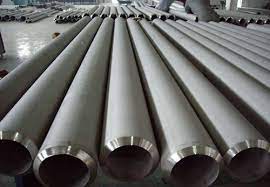

When it comes to carbon steel seamless pipe used in industrial applications, two of the most commonly referenced specifications are ASTM A106 Grade B and ASTM A53 Grade B Type S. Though these grades may appear similar at a glance, both being seamless carbon steel pipe with comparable mechanical properties, they are designed for different purposes. They are governed by distinct testing and manufacturing standards.
In this post, we’ll break down the key differences between these two pipe grades, helping you choose the right material for your next piping project.
Specification Overviews
ASTM A106 Grade B – High-Temperature Pressure Pipe
ASTM A106 (also known as ASME SA106) is a seamless carbon steel pipe specification intended for high-temperature and high-pressure service. It’s commonly used in:
-
Refineries
-
Power plants
-
Boilers and heat exchangers
-
Petrochemical processing
The seamless construction makes A106 ideal for demanding conditions involving heat, pressure, and cyclic loading.
ASTM A53 Grade B Type S – General-Purpose Seamless Pipe
ASTM A53 covers seamless (Type S) and welded (Types E and F) black and hot-dipped galvanized steel pipe. Type S refers specifically to seamless pipe. It's widely used for:
-
Mechanical and low-pressure systems
-
Air, water, and gas lines
-
Fire protection systems
-
Structural and coated applications
Though similar in appearance, A53 is geared toward general service applications rather than extreme conditions.
Mechanical Properties Comparison
| Property | ASTM A106 Grade B | ASTM A53 Grade B Type S |
|---|---|---|
| Tensile Strength | ≥ 60,000 psi | ≥ 60,000 psi |
| Yield Strength | ≥ 35,000 psi | ≥ 35,000 psi |
| Elongation | 30% minimum (in 2") | 30% minimum (in 2") |
| Max Operating Temp | ~750°F (400°C) and above | Ambient to ~500°F |
Though the tensile and yield strengths are identical, A106 is manufactured with higher temperature service in mind, often undergoing more stringent testing.
Chemical Composition
| Element | ASTM A106 Gr. B | ASTM A53 Gr. B |
|---|---|---|
| Carbon (C) | 0.30% max | 0.30% max |
| Manganese | 0.29–1.06% | 1.20% max |
| Phosphorus | 0.035% max | 0.05% max |
| Sulfur | 0.035% max | 0.045% max |
A106 has tighter limits on impurities (P and S), making it better suited for elevated temperatures and corrosion resistance.
Manufacturing & Testing Requirements
| Feature/Test | A106 Gr. B | A53 Gr. B Type S |
|---|---|---|
| Seamless only | Yes | Yes |
| Heat treatment | Often normalized or annealed | Not required |
| Hydrostatic testing | Required | Required |
| NDE (Nondestructive Exam) | Optional unless specified | Required unless waived |
| Flattening & Bending Test | Required | Optional |
| Grain Size Control | Required for some grades | Not required |
ASTM A106 is tested more rigorously and includes additional metallurgical controls, making it a more reliable choice in high-stress environments.
Application Differences
| Application | Preferred Specification |
|---|---|
| High-temp process piping (boilers, etc.) | ASTM A106 Grade B |
| Steam lines, high-pressure service | ASTM A106 Grade B |
| Compressed air or water lines | ASTM A53 Grade B Type S |
| Fire protection/sprinkler systems | ASTM A53 (ERW or Seamless) |
| Structural or coated pipe applications | ASTM A53 Grade B |
Cost & Availability
We have found that global mills today do not produce A53 Grade B Type S as a separate commodity. Nearly all seamless pipe is produced to meet all three common seamless standards: A53, A106, and API 5L. Because of this, there is no real difference in the cost or availability of these grades. One pipe meets all three standards.
Summary: Which One Should You Choose?
-
Choose ASTM A106 Grade B when:
-
Your project involves high heat or pressure
-
You require greater metallurgical control
-
You're working in refineries, chemical plants, or power plants
-
-
Choose ASTM A53 Grade B Type S when:
-
The system operates under ambient temperature and pressure
-
You need standard mechanical or structural pipe
-
You're looking for a cost-effective general-use pipe
-
We believe specifications should be written for the specific application. That said, when you receive material on the jobsite, it will most likely meet both standards.
Need Help Specifying Pipe?
At Hayward Pipe & Supply Co., we stock a wide range of A106 and A53 carbon steel pipe in a variety of sizes, schedules, and end connections. We also provide mill test reports (MTRs), cut-to-length service, and fast delivery from strategically located warehouses.
Contact us today to help you select the right pipe specification for your job.
Visit: www.haywardpipe.com
Email: sales@haywardpipe.com
Phone: (510) 887-2700

